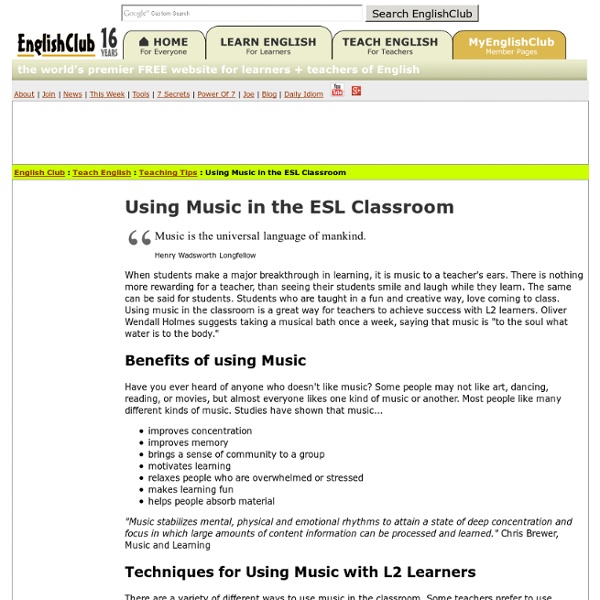Using Music in the ESL Classroom
Music is the universal language of mankind.Henry Wadsworth Longfellow When students make a major breakthrough in learning, it is music to a teacher's ears. There is nothing more rewarding for a teacher, than seeing their students smile and laugh while they learn. The same can be said for students. Benefits of using Music Have you ever heard of anyone who doesn't like music? "Music stabilizes mental, physical and emotional rhythms to attain a state of deep concentration and focus in which large amounts of content information can be processed and learned." Techniques for Using Music with L2 Learners There are a variety of different ways to use music in the classroom. Suggested Activities Many teachers try using music once in the class, but forget to do it again. Teaching Kids with Music Using music with ESL kids has all of the same benefits mentioned above and more. Tips for Using Music Effectively Online Materials and Resources
Sounds Historic
About Age range: Good for 10-13 year olds Estimated Time: Give yourself some time! This interactive takes about 30 minutes to complete. Key Technology: You will need speakers (or headphones) for the music parts, Flash Player version 10 or higher, and Adobe Reader. This interactive site explores how music is inspired by history, makes history itself, or captures an important place and time. Think About... Don’t forget to try the listening activities for each of the pieces! Listen to Russell Nadel’s finished composition. Did You Get It? What are the three things that Russell Nadel says that a new composition needs to be? Think About It! Can you think of any other pieces of music that are influenced by history? What’s Your Take? What historic event would inspire you to write a piece of music? next: Learn More > < previous: About Learn More Try It Yourself! Compose your own music on these great sites: For the Educator Trying to spice up a history lesson? Instructional Strategies
Listen to the Oldest Song in the World: A Sumerian Hymn Written 3,400 Years Ago
In the early 1950s, archaeologists unearthed several clay tablets from the 14th century B.C.E.. Found, WFMU tells us, “in the ancient Syrian city of Ugarit,” these tablets “contained cuneiform signs in the hurrian language," which turned out to be the oldest known piece of music ever discovered, a 3,400 year-old cult hymn. Anne Draffkorn Kilmer, professor of Assyriology at the University of California, produced the interpretation above in 1972. (She describes how she arrived at the musical notation—in some technical detail—in this interview.) Since her initial publications in the 60s on the ancient Sumerian tablets and the musical theory found within, other scholars of the ancient world have published their own versions. The piece, writes Richard Fink in a 1988 Archeologia Musicalis article, confirms a theory that “the 7-note diatonic scale as well as harmony existed 3,400 years ago.” via WFMU Would you like to support the mission of Open Culture? Related Content:
Related:
Related:



